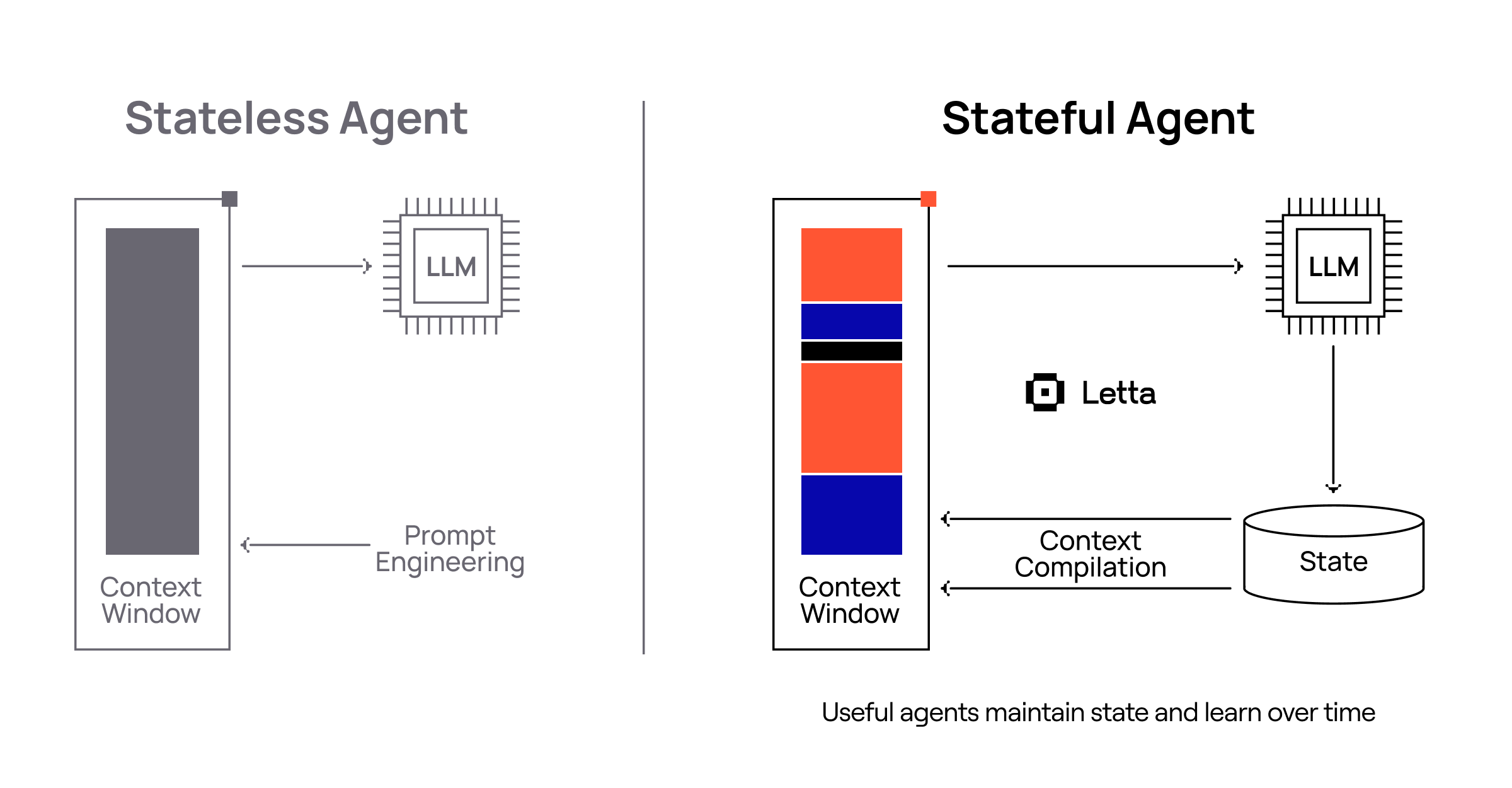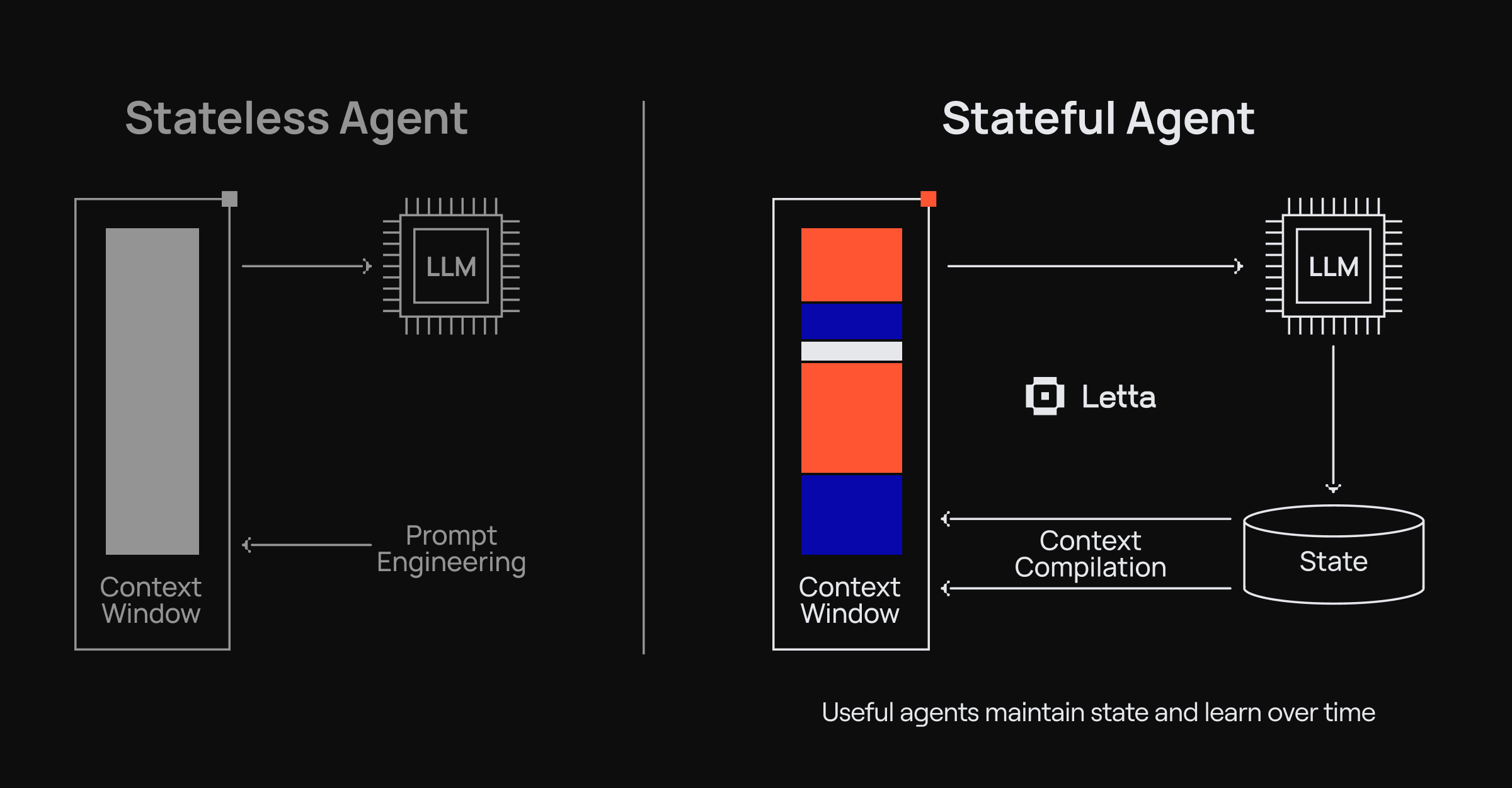Building stateful agents
Comprehensive guide to Letta agents including creation, configuration, and management.
Letta agents can automatically manage long-term memory, load data from external sources, and call custom tools. Unlike in other frameworks, Letta agents are stateful, so they keep track of historical interactions and reserve part of their context to read and write memories which evolve over time.


Letta manages a reasoning loop for agents. At each agent step (i.e. iteration of the loop), the state of the agent is checkpointed and persisted to the database.
You can interact with agents from a REST API, the ADE, and TypeScript / Python SDKs. As long as they are connected to the same service, all of these interfaces can be used to interact with the same agents.
Agents vs Threads
Section titled “Agents vs Threads”In Letta, you can think of an agent as a single entity that has a single message history which is treated as infinite. The sequence of interactions the agent has experienced through its existence make up the agent’s state (or memory).
One distinction between Letta and other agent frameworks is that Letta does not have the notion of message threads (or sessions). Instead, there are only stateful agents, which have a single perpetual thread (sequence of messages).
The reason we use the term agent rather than thread is because Letta is based on the principle that all agents interactions should be part of the persistent memory, as opposed to building agent applications around ephemeral, short-lived interactions (like a thread or session).
%%{init: {'flowchart': {'rankDir': 'LR'}}}%%
flowchart LR
subgraph Traditional["Thread-Based Agents"]
direction TB
llm1[LLM] --> thread1["Thread 1
--------
Ephemeral
Session"]
llm1 --> thread2["Thread 2
--------
Ephemeral
Session"]
llm1 --> thread3["Thread 3
--------
Ephemeral
Session"]
end
Traditional ~~~ Letta
subgraph Letta["Letta Stateful Agents"]
direction TB
llm2[LLM] --> agent["Single Agent
--------
Persistent Memory"]
agent --> db[(PostgreSQL)]
db -->|"Learn & Update"| agent
end
class thread1,thread2,thread3 session
class agent agent
If you would like to create common starting points for new conversation “threads”, we recommending using agent templates to create new agents for each conversation, or directly copying agent state from an existing agent.
For multi-users applications, we recommend creating an agent per-user, though you can also have multiple users message a single agent (but it will be a single shared message history).
Create an agent
Section titled “Create an agent”You can create a new agent via the REST API, Python SDK, or TypeScript SDK:
curl -X POST https://api.letta.com/v1/agents \ -H "Authorization: Bearer $LETTA_API_KEY" \ -H "Content-Type: application/json" \ -d '{ "memory_blocks": [ { "value": "The human'\''s name is Bob the Builder.", "label": "human" }, { "value": "My name is Sam, the all-knowing sentient AI.", "label": "persona" } ], "model": "openai/gpt-4o-mini", "context_window_limit": 16000}'# install letta_client with `pip install letta-client`from letta_client import Lettaimport os
# create a client connected to Letta Cloud (uses api.letta.com by default)
client = Letta(api_key=os.getenv("LETTA_API_KEY"))
# create an agent with two basic self-editing memory blocks
agent_state = client.agents.create( memory_blocks=[ { "label": "human", "value": "The human's name is Bob the Builder." }, { "label": "persona", "value": "My name is Sam, the all-knowing sentient AI." } ], model="openai/gpt-4o-mini", context_window_limit=16000)
# the AgentState object contains all the information about the agent
print(agent_state)// install letta-client with `npm install @letta-ai/letta-client`import Letta from "@letta-ai/letta-client";
// create a client connected to Letta Cloud (uses api.letta.com by default)const client = new Letta({ apiKey: process.env.LETTA_API_KEY,});
// create an agent with two basic self-editing memory blocksconst agentState = await client.agents.create({ memory_blocks: [ { label: "human", value: "The human's name is Bob the Builder.", }, { label: "persona", value: "My name is Sam, the all-knowing sentient AI.", }, ], model: "openai/gpt-4o-mini", context_window_limit: 16000,});
// the AgentState object contains all the information about the agentconsole.log(agentState);You can also create an agent without any code using the Agent Development Environment (ADE). All Letta agents are stored in a database on the Letta server, so you can access the same agents from the ADE, the REST API, the Python SDK, and the TypeScript SDK.
The response will include information about the agent, including its id:
{ "id": "agent-43f8e098-1021-4545-9395-446f788d7389", "name": "GracefulFirefly", ...}Once an agent is created, you can message it:
curl --request POST \ --url https://api.letta.com/v1/agents/$AGENT_ID/messages \ --header 'Authorization: Bearer $LETTA_API_KEY' \ --header 'Content-Type: application/json' \ --data '{ "messages": [ { "role": "user", "content": "hows it going????" } ]}'# send a message to the agentresponse = client.agents.messages.create( agent_id=agent_state.id, messages=[ { "role": "user", "content": "hows it going????" } ])
# the response object contains the messages and usage statistics
print(response)
# if we want to print the usage stats
print(response.usage)
# if we want to print the messages
for message in response.messages:print(message)// send a message to the agentconst response = await client.agents.messages.create(agentState.id, { messages: [ { role: "user", content: "hows it going????", }, ],});
// the response object contains the messages and usage statisticsconsole.log(response);
// if we want to print the usage statsconsole.log(response.usage);
// if we want to print the messagesfor (const message of response.messages) { console.log(message);}Common agent operations
Section titled “Common agent operations”For more in-depth guide on the full set of Letta agent operations, check out our API reference, our extended Python SDK and TypeScript SDK examples, as well as our other tutorials.
If you’re using a self-hosted Letta server, you should set the base URL (base_url in Python, baseUrl in TypeScript) to the Letta server’s URL (e.g. http://localhost:8283) when you create your client. See an example here.
If you’re using a self-hosted server, you can omit the token if you’re not using password protection. If you are using password protection, set your token to the password. If you’re using Letta Cloud, you should set the token to your Letta Cloud API key.
Retrieving an agent’s state
Section titled “Retrieving an agent’s state”The agent’s state is always persisted, so you can retrieve an agent’s state by its ID using the GET /v1/agents/:agent_id endpoint.
List agents
Section titled “List agents”You can list all agents using the GET /v1/agents/ endpoint.
Delete an agent
Section titled “Delete an agent”To delete an agent, you can use the DELETE /v1/agents/:agent_id endpoint.